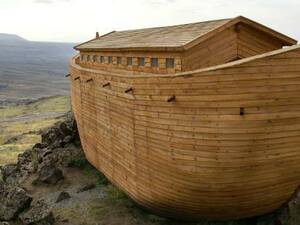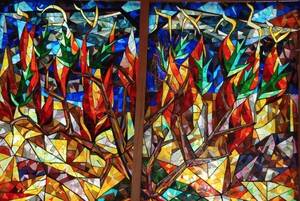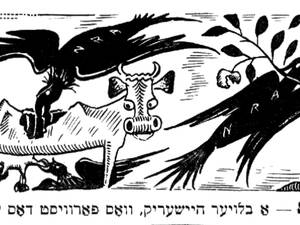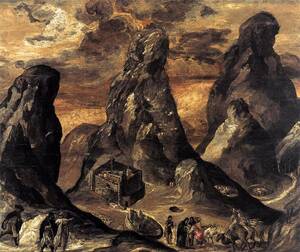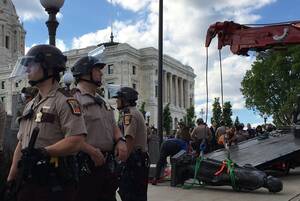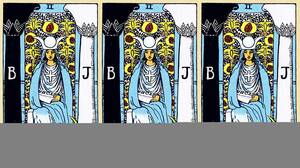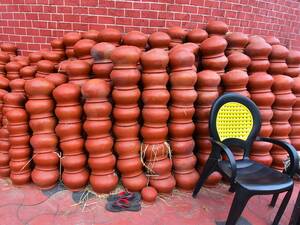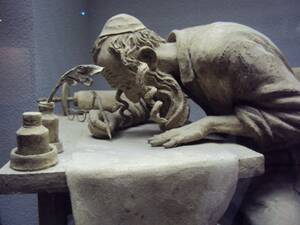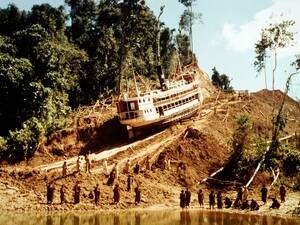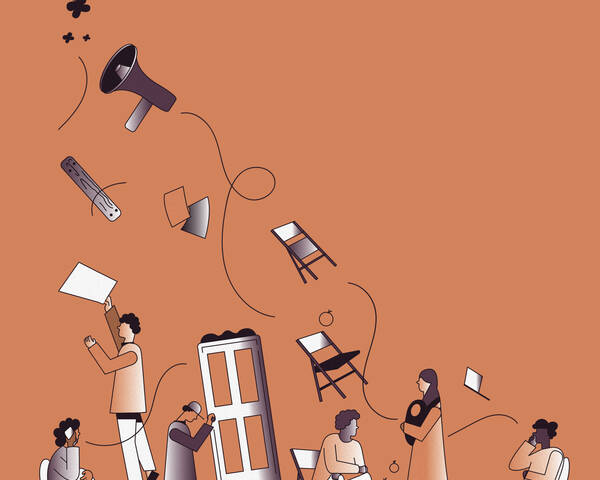Exodus: Terumah
Does the Tabernacle represent God’s effort to institutionalize the energy of a riot?
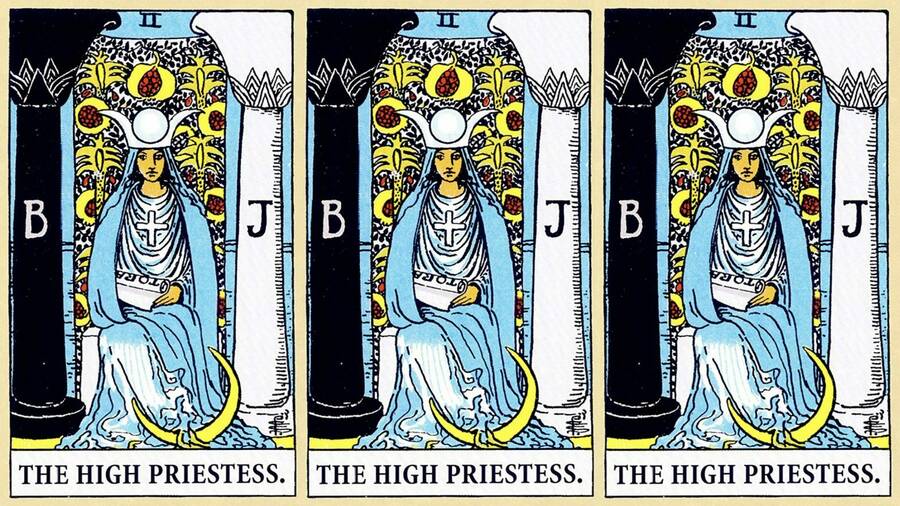
Read previous entries of Slow Burn: Quarantine Edition here.
Terumah
Exodus 25:1 – 27:19
New York, NY
Dear People of the Book,
I can’t keep track of Moses and it’s making me crazy. Even after he comes through with the commandments, he’s MIA. The sixth parsha of Exodus, Mishpatim, ends with Moses disappearing “into the cloud” atop Mount Sinai, where “the sight of the LORD’s glory was like consuming fire.” Meanwhile, among the unchosen masses of the chosen people, conditions remain ominously mundane. For “forty days and forty nights,” they mill about with no word from either God or His messenger, while the storm at Sinai’s summit casts a roiling shadow over the refugee camp. Riot weather.
And a riot—or is it an uprising?—or is it a block party?—or is it a prayer?—does eventually transpire: the Riot of the Golden Calf. In fact, Moses does not descend again from Mount Sinai until God, viewing the whole scene from His omniscient perch, alerts him to the trouble in the streets. “Quick, go down, for your people . . . have acted ruinously,” God says in Robert Alter’s translation. “They have swerved quickly from the way I charged them.” Together, the people melt down their earrings and bracelets to forge a luminous sacred object. Together, they feast, dance, and make offerings: They improvise a festival of the Lord. I think of the Golden Calf incident as a riot because it responds so directly to a failure of leadership. “Moses lagged” in establishing a viable line of communication between God and his people, so the people “rise up” and begin to build their own spiritual society. The Riot of the Golden Calf is an attempt to make direct contact with God—one that demands and manifests divine presence through collective action.
But not in this parsha. Terumah, the seventh parsha in Exodus, takes place in the long meantime. Terumah is an upscale IKEA pamphlet, a set of elaborate instructions from God—presumably dictated to Moses, on Sinai—for the construction of a luxurious glamping compound. This Tabernacle is meant to be His “dwelling place” among the people, who are anxious, exhausted, and above all, hungry for His presence. Given these conditions, His architectural plan seems a little out of touch. A lampstand of “pure gold”? Extra virgin olive oil expressed by hand? Lapis lazuli? Red, purple, and indigo Phoenician linen? As Alter concedes in his commentary, “it is hard to imagine” these A grade materials “would have been accessible . . . in the wilderness.” And “designer’s work you shall make them,” God demands—knockoffs are not welcome. In this economy!
The experience of reading the Torah, like the experience of life as we live it, feels chaotic. It takes work, and reflection, to find a plot (as Omari put it a few weeks ago) in the wandering. As far as I can tell, Terumah and the parshas that follow—Tetzaveh, in which the Levites are named as the priestly class, and Ki Tissa, in which the Riot of the Golden Calf transpires—are all part of one extended scene: On the mountaintop, God and Moses discuss rules and regulations, while down below, the people grow desperate in the dust. Since they receive word of God’s will only through Moses, we have to assume that they are told His plans for the Tabernacle only after they have already claimed, illegally, their own kind of sacred space. Did God, keeping one eye on the street as He trained his deputy, come up with the Tabernacle plan on the spot, precisely in an attempt to contain all that anarchic self-determination?
Though the text doesn’t say so directly, I can’t help reading the Tabernacle—with its bicameral design, its many borders and prohibitions, its lavish display of taxpayer dollars—as God’s effort to placate and institutionalize the riot’s energy, to “busy” the people, as Sarah wrote in her letter on the parsha Mishpatim, “with lines and lines of civic code.” Indeed, in his Guide for the Perplexed, Maimonides explicitly describes the Tabernacle and its luminous accoutrements as “alternates” to the idols produced in the Riot of the Golden Calf. There’s the promise of direct contact, yes—but with strict limits. Only His specially designated functionaries, the Levites, shall “take it down and set it up again.” And oh—the people are asked to foot the bill for the compound’s construction via a “donation from every man”—no federal subsidies for labor or supplies.
What we have, then, is an ideological battle over two models of sacred space: the sacred space spontaneously claimed by the people, and the abstract ideal of a legislatively sanctioned alternative. Ultimately, the promise of the Tabernacle seems like too little too late: retroactive compensation for a long period of political and spiritual abandonment—not just in Egypt, but in the wilderness, where even Moses disappears without warning like a deadbeat dad. And the VIP system that regulated access to Mount Sinai—that triggered the riot in the first place—is not really reformed in relation to the Tabernacle. It is reproduced on pain of death: “anyone . . . who goes too near the Tabernacle will be executed.”
RIGHT NOW, WE ARE living through a radical reconfiguration of space. Most of the usual sites of assembly are out of service: the synagogues and churches, the nightclubs and bookstores and dive bars. Private businesses have, for the moment, lost much of their power to organize and regulate the way we gather and the way we move. We’re forced out in public. Many people, of course, were always already there, dodging charges of “loitering,” resisting the “noise complaints” of gentrifying neighbors, searching for a park bench the city hadn’t yet made unsleepable.
Motown’s Mickey Stevenson said he was inspired to write “Dancing in the Street” when he saw some young Black kids catching rainbows in a Detroit fire hydrant. It’s not surprising that the version of the song recorded by Martha and the Vandellas in 1964 became a protest anthem. Collective pleasure in the unrelenting haze of ghetto heat turned out to be revolutionary: Those kids could only cool off by seizing state property. “They’re dancing in Chicago (dancing in the street) / Down in New Orleans (dancing in the street) / In New York City (dancing in the street).” As in the Riot of the Golden Calf, a sense of roving, uncontainable eventfulness has superseded the Tabernacle. Whose streets? Our streets! They’re sacred now.
Have I rejected the Tabernacle too hastily? Squandered its revolutionary potential? Some rabbis and biblical scholars distinguish between the elaborately legislated Tabernacle described in Terumah and a more modest structure Exodus tells us was situated at the margins of the Israelite camp, where the wilderness beckoned. The same word, “mishkan”—it shares a root with “shakan,” the word for “dwell”—is used for both, but the various authors of Exodus used it, well, variously. In the glossary of his book Radical Judaism, Arthur Green defines the mishkan, “the tabernacle of God’s presence in Exodus,” as “any dwelling place for the divine Presence in this world.” Martin Buber, in his essay from On the Bible about the middle chapters of Exodus, writes that “the true character of the ancient nomad deity” is not “limited to any form of revelation.” Buber’s God “does not allow Himself to be kept to any mountain or temple.”
These alternate meanings, translations, and interpretations remind us that even (especially?) among believers, the status of sacred space remains unsettled. But perhaps that is just the nature of such space—that it should never settle. Then as now, Jewish thought registers profound ambivalence about whether it is possible or desirable to establish a permanent dwelling place for God or His chosen people. For those of us who embrace any kind of diasporic identity—not as punishment, but as practice—there’s something profound and thrilling about the Tabernacle’s portability. It certainly seems more sustainable than the Temple, which King Solomon built with slave labor on stolen land, and which was eventually, inevitably, destroyed anyway.
Alongside Exodus, I’ve been learning to read another ancient, syncretic text: the Tarot. Terumah reminds me of the High Priestess, who sits between two pillars representing the Tabernacle. In her book Seventy-Eight Degrees of Wisdom, Rachel Pollack—a trans Jewish scholar of the Tarot—suggests we might understand the High Priestess as an embodiment of the shekinah, a concept that does not appear in scripture proper, but in the Talmud and later in the mystical texts of the Kabbalah. Linguistically related to “shakan” and “mishkan”, “shekinah” refers to the “feminine attributes of the presence of God,” which is “said to dwell within the veiled ark of the Tabernacle.” The Tarot represents this presence in flesh and blood. Jewish law as traditionally practiced prohibits women from occupying the bima or touching the Torah, so the position of the High Priestess on her card can be understood as actively transgressive.
In divinatory readings, the High Priestess is associated with what’s hidden from us as well as what we hide from ourselves. “Most people assume we are somehow forbidden” from entering the Holy of Holies, writes Pollack, “when in reality, we simply do not know how to.” From the perspective of the Law, we may well be forbidden. But “if we cannot penetrate the veil, the Tabernacle remains for us an empty place, devoid of meaning.” Space, in other words, is made sacred by our willingness to transgress the laws that regulate it. Whose streets? Our streets!
In wonder and solidarity,
Carina
Carina del Valle Schorske is a writer and translator living between San Juan, Puerto Rico, and New York City, where she is a PhD candidate in comparative literature at Columbia University. Her first book, The Other Island, is forthcoming from Riverhead.
